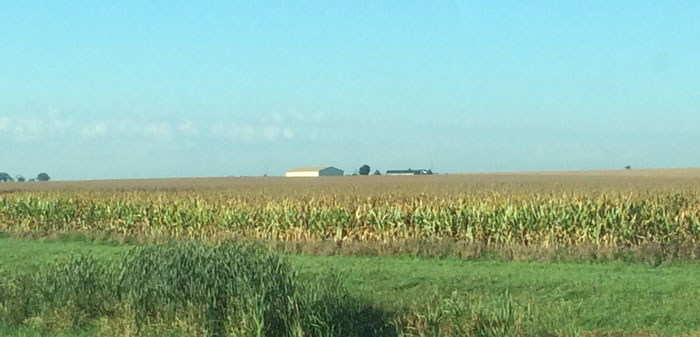By Andy Whitman, Director, Sustainable Economies Program
Andy Whitman’s work to create an environmental sustainability standard for agriculture takes him to America’s Heartland.
After years of work on sustainable agriculture, I set out this fall to test a single environmental sustainability standard for agriculture on seven farms. My first trip through the Midwest begged two questions: Can one set of indicators be used to assess the sustainability of farms growing different crops across the U.S.? By this point, I was pretty certain that the answer to this question was yes, but I am always looking for those curveballs from resource managers that can take a well-conceived idea and make it better. The second question was the one keeping me up at night: Can I walk a dozen different farm managers through this sustainability standards draft, while avoiding the proverbial “cow patties” and hit the essence of sustainability in American agriculture?

Pollinating the cranberry bed.
Photo credit: Andy Whitman, Director,
Sustainable Economies Program
My first field visit was a swing through the American heartland, near the rolling hills of Lacrosse, Wisconsin. Lacrosse was where my father was born when my grandfather worked briefly for the Great Northern Railroad long ago, a far-off place that I never expected to visit. Here, I joined up with Brian Kernohan, Director of Policy & Environmental Advocacy at Hancock Natural Resource Group; Holly Evers, Sustainability Coordinator at Hancock Agricultural Investment Group (HAIG); and a group of farm managers to see and talk about sustainability on a cranberry operation directly operated by HAIG farm managers.
While some of the terms used are different—“bogs” in Massachusetts become “beds” in Wisconsin—many of the management principles remain the same. Like Massachusetts cranberry operations, this operation closely managed soils, water, agricultural chemicals, and energy in order to produce a crop and protect natural resources. A large area of the operation was lightly managed forestland which provides habitat for many wildlife species. Remarkably, our conversation mostly focused on small points about the wording of the draft indicators and little on the indicators. My first visit was done, and so far, I stayed clear of those cow patties!
A long drive into the Corn Belt took us to our next stop near Savoy in central Illinois. The flatness and vastness of the corn fields were familiar to me having lived there for eight years. This corn and soybeans operation had erosion problems when the investor purchased the land, but HAIG was quick to remedy the issues by filling in and converting gullies into grassed waterways to allow water movement, but stop soil erosion. Remedies like this are a standard practice for HAIG on newly-acquired lands to fix any problems before they undermine the value of property. This was a lease operation which greatly limits HAIG managers’ ability to influence day-to-day farm operations. However, HAIG’s soil erosion remedy helped erosion-proof the operation and minimize soil erosion problems from the start. At this farm, our conversation focused on how the draft indicators might ensure environmental stewardship, yet avoid crossing the legal boundaries of the lease agreement which provides an implied covenant of quiet enjoyment to the tenant.

The Corn Belt
Photo credit: Andy Whitman, Director, Sustainable Economies Program
Another long drive took us to our final stop in the Delta Bottomlands of Arkansas—not far from Memphis, Tennessee—to visit a tenant-operated rice and soybeans operation. It reminded me of trips to Texas and Louisiana rice fields for shorebirds, and I was rewarded with views of hundreds of migrating Killdeers. But there is nothing like farmland in the Delta with its rich history and culture, flatness and river systems, blues, and barbecue!—a far cry from New England. It was good to have long conversations with managers about their challenges and legal constraints for stewardship on tenant operated lands and how to integrate stewardship into the lease when the land is purchased.
Together with HAIG, we are working toward a good solution about tenant lands but have many conversations to go. With the exception of this one challenge, the draft indicators may just work for the full diversity of agriculture in the U.S. In the next Manomet newsletter, I will talk about my findings from my final tour of farms from around the U.S. and let you know if we’ve been able to avoid all of the potential pitfalls!





 Back to all
Back to all